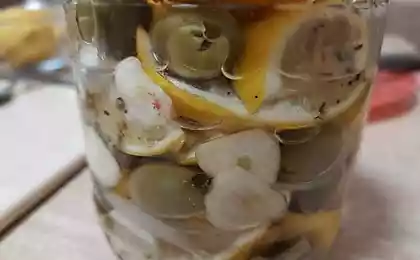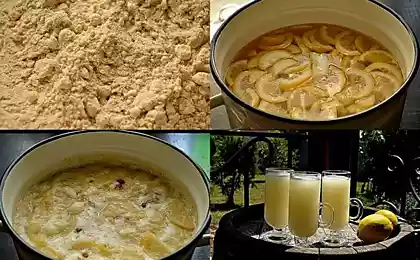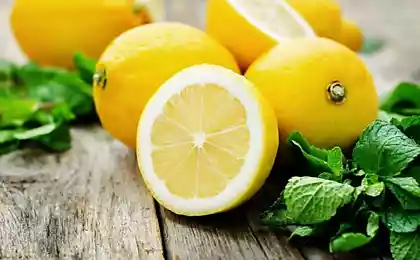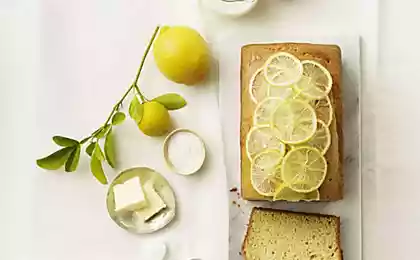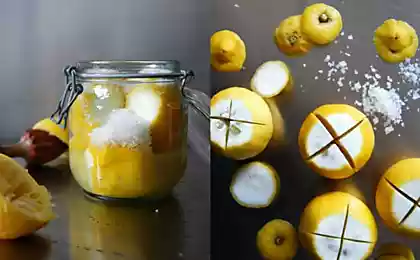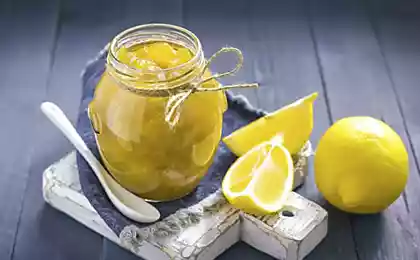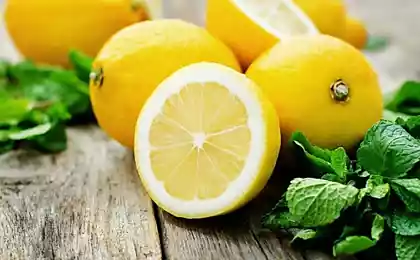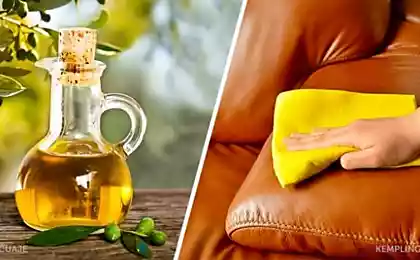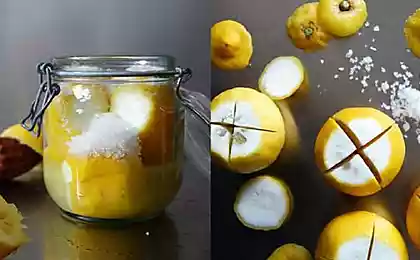3496
22 way to use lemon
If life gave you a lemon, make lemonade. But what to do with all this zest? Do not throw it away - even if it will work. Lemon juice contains about 5-6% citric acid and the pH between 2 and 3. This makes it the ideal companion for the safe cleansing kitchen surfaces of the scum and mineral stains, writes povarenok.ru.
Housing:
1. Remove grease marks
Bold raid on the pans? Thickets of cooking fat burners? If your kitchen was a victim saute, try using half a lemon before you resort to using toxic cleaning products. Sprinkle a little salt (for abrasion) on half a lemon and rub her greasy stain, then wipe the surface with a cloth. (Be careful with marble surfaces, or any other sensitive to acids).
2. Cleaning the kettle or coffee maker
Descaling, resulting in your kettle, fill it with water, add a handful of chopped lemon peel and put it all on fire. After boiling, leave the kettle with this liquid to stand an hour, pour the liquid and rinse well with tea. To cleanse coffee makers need to put it in ice, salt and lemon zest, a good shake it all a minute or two, shake and rinse the coffee maker. All glistens!
3. Purification microwave
Cooking in the microwave, especially unfortunate, usually leads to a rapid loss of cleanliness and appearance of the latter. Stains may look like pieces of dried cement. Before you pick up a chemical cleaning agent, try this: add the lemon zest in a bowl for microwave oven, half-filled with water. Turn the oven on full power for 5 minutes, let the water boil and condense on the walls of a pair of microwave. Then just remove the bowl and wipe all this dirt with a damp cloth.
4. Deodorization bin
Use lemon zest can also deodorize for a place with the most unpleasant smell - bins - and to give the kitchen a fresh fragrance. Incidentally, this is a good use of lemon after the last application on some other of these tips.
5. Polished chrome surfaces
Mineral cake chrome faucet, however, as on other surfaces of the metal, is easily removed with the help of a lemon. Rub the surface of a half a lemon squeezed, wash and lightly buff with a soft cloth.
6. Polishing copper surfaces
Half of lemon dipped in salt or baking soda can be used to cleanse and refresh utensils of copper, brass and of stainless steel kitchenware . This is necessary to rub half a lemon polluted place and leave for 5 minutes. Then the dishes should be washed with warm water and polish dry.
7. Cleaning stainless steel sinks
Use the same method as for cleaning chrome-plated surfaces.
8. insect repellent
Many animals have an aversion to citric acid. You can slice a lemon and put the slices on the threshold, window sills, near cracks and holes through which uninvited guests in the form of ants and other insect pests can get into your home.
9. Making flavored humidifier
If winter air in your dwelling sapped heating, the aid will come again lemon. Fill a bowl with water, put in the water lemon zest and put on the stove. After boiling, do the minimum fire and leave so for some time. The air is filled with moisturizing and fresh aroma.
10. Freshen cutting board
Because of the low pH level Lemon has antibacterial properties, making it an excellent means of purification of many kitchen surfaces, including cutting boards. After disinfection, rub the surface of the board half a lemon, let it sit for a few minutes and rinse.
In food:
11. Save the flowability of brown sugar
If your brown sugar is more like a refined, try adding a little lemon peel (removing the first with her all traces of peel) to maintain its moisture and bulk properties. (All recipes using lemon peel is always good to clean the surface from dirt and wax).
12. Dried peel
Lemon peel can grate, and it will retain all the flavor of lemon. Use the peel can be fresh, dried or frozen. (If you know that you will harvest peel easier to rub it on the grate when she was still on a lemon before you squeeze the juice). To dry the peel, sprinkle a thin layer on a towel and leave to dry completely, then pour the into the jar. To freeze the peel, use the special container for freezing food. Application of lemon peel is in salads, marinades, baked goods, cereal products, etc.
13. Preparation of biscuits with lemon peel
If you have prepared rind, be sure to add it to the liver. It will surprise you with its amazing taste!
14. The flagella of lemon peel
Strips of lemon peel, which at zasushivanii twisted into flagella, are good for use in cocktails, soda or regular drinking water. Use their preparation peeler or a knife, carefully remove the bitter white flesh. These flagella also can be frozen in a container or package.
15. Preparation of lemon extract
Make flagella from lemon peel (above) and dry them down onto the outer side of the plate for 3-4 days. Put them in a blender and grind to a state of flour. Use as an extract in the recipes.
16. Preparation of lemon sugar
You can add sugar ready lemon extract (above) or put in a jar with sugar and fresh lemon peel flagella of that sugar could absorb their oil.
17. Preparation of lemon pepper
Mix lemon extract (above) with freshly ground pepper.
18. Candied
You can also cook candied grapefruit peel. Candied easy to prepare, because it's just candied peel, and there they can just dipping in melted chocolate, add biscuits, sweets or bread.
Beauty:
19. Lighten age spots
Many folk recipes suggest using lemon peel to lighten age spots. To do this, place a small piece of lemon peel on the stain and let it sit for an hour.
20. Soften dry elbows
Use half a lemon, sprinkled with baking soda. Just drop an elbow in the lemon and twist it a few minutes, as if going to squeeze the juice out of it. Then rinse and dry elbows.
21. The use of the skin
Lemon zest can be an excellent tonic when she lightly rubbed the skin, avoiding the eye area.
22. Production of sugar scrub
Mix half a cup of sugar with lemon zest and olive oil until the consistency of sour cream. Moisten the skin of the body in the shower, turn off the water and massage movements apply the mixture on the skin, then rinse.
Housing:
1. Remove grease marks
Bold raid on the pans? Thickets of cooking fat burners? If your kitchen was a victim saute, try using half a lemon before you resort to using toxic cleaning products. Sprinkle a little salt (for abrasion) on half a lemon and rub her greasy stain, then wipe the surface with a cloth. (Be careful with marble surfaces, or any other sensitive to acids).
2. Cleaning the kettle or coffee maker
Descaling, resulting in your kettle, fill it with water, add a handful of chopped lemon peel and put it all on fire. After boiling, leave the kettle with this liquid to stand an hour, pour the liquid and rinse well with tea. To cleanse coffee makers need to put it in ice, salt and lemon zest, a good shake it all a minute or two, shake and rinse the coffee maker. All glistens!
3. Purification microwave
Cooking in the microwave, especially unfortunate, usually leads to a rapid loss of cleanliness and appearance of the latter. Stains may look like pieces of dried cement. Before you pick up a chemical cleaning agent, try this: add the lemon zest in a bowl for microwave oven, half-filled with water. Turn the oven on full power for 5 minutes, let the water boil and condense on the walls of a pair of microwave. Then just remove the bowl and wipe all this dirt with a damp cloth.
4. Deodorization bin
Use lemon zest can also deodorize for a place with the most unpleasant smell - bins - and to give the kitchen a fresh fragrance. Incidentally, this is a good use of lemon after the last application on some other of these tips.
5. Polished chrome surfaces
Mineral cake chrome faucet, however, as on other surfaces of the metal, is easily removed with the help of a lemon. Rub the surface of a half a lemon squeezed, wash and lightly buff with a soft cloth.
6. Polishing copper surfaces
Half of lemon dipped in salt or baking soda can be used to cleanse and refresh utensils of copper, brass and of stainless steel kitchenware . This is necessary to rub half a lemon polluted place and leave for 5 minutes. Then the dishes should be washed with warm water and polish dry.
7. Cleaning stainless steel sinks
Use the same method as for cleaning chrome-plated surfaces.
8. insect repellent
Many animals have an aversion to citric acid. You can slice a lemon and put the slices on the threshold, window sills, near cracks and holes through which uninvited guests in the form of ants and other insect pests can get into your home.
9. Making flavored humidifier
If winter air in your dwelling sapped heating, the aid will come again lemon. Fill a bowl with water, put in the water lemon zest and put on the stove. After boiling, do the minimum fire and leave so for some time. The air is filled with moisturizing and fresh aroma.
10. Freshen cutting board
Because of the low pH level Lemon has antibacterial properties, making it an excellent means of purification of many kitchen surfaces, including cutting boards. After disinfection, rub the surface of the board half a lemon, let it sit for a few minutes and rinse.
In food:
11. Save the flowability of brown sugar
If your brown sugar is more like a refined, try adding a little lemon peel (removing the first with her all traces of peel) to maintain its moisture and bulk properties. (All recipes using lemon peel is always good to clean the surface from dirt and wax).
12. Dried peel
Lemon peel can grate, and it will retain all the flavor of lemon. Use the peel can be fresh, dried or frozen. (If you know that you will harvest peel easier to rub it on the grate when she was still on a lemon before you squeeze the juice). To dry the peel, sprinkle a thin layer on a towel and leave to dry completely, then pour the into the jar. To freeze the peel, use the special container for freezing food. Application of lemon peel is in salads, marinades, baked goods, cereal products, etc.
13. Preparation of biscuits with lemon peel
If you have prepared rind, be sure to add it to the liver. It will surprise you with its amazing taste!
14. The flagella of lemon peel
Strips of lemon peel, which at zasushivanii twisted into flagella, are good for use in cocktails, soda or regular drinking water. Use their preparation peeler or a knife, carefully remove the bitter white flesh. These flagella also can be frozen in a container or package.
15. Preparation of lemon extract
Make flagella from lemon peel (above) and dry them down onto the outer side of the plate for 3-4 days. Put them in a blender and grind to a state of flour. Use as an extract in the recipes.
16. Preparation of lemon sugar
You can add sugar ready lemon extract (above) or put in a jar with sugar and fresh lemon peel flagella of that sugar could absorb their oil.
17. Preparation of lemon pepper
Mix lemon extract (above) with freshly ground pepper.
18. Candied
You can also cook candied grapefruit peel. Candied easy to prepare, because it's just candied peel, and there they can just dipping in melted chocolate, add biscuits, sweets or bread.
Beauty:
19. Lighten age spots
Many folk recipes suggest using lemon peel to lighten age spots. To do this, place a small piece of lemon peel on the stain and let it sit for an hour.
20. Soften dry elbows
Use half a lemon, sprinkled with baking soda. Just drop an elbow in the lemon and twist it a few minutes, as if going to squeeze the juice out of it. Then rinse and dry elbows.
21. The use of the skin
Lemon zest can be an excellent tonic when she lightly rubbed the skin, avoiding the eye area.
22. Production of sugar scrub
Mix half a cup of sugar with lemon zest and olive oil until the consistency of sour cream. Moisten the skin of the body in the shower, turn off the water and massage movements apply the mixture on the skin, then rinse.


